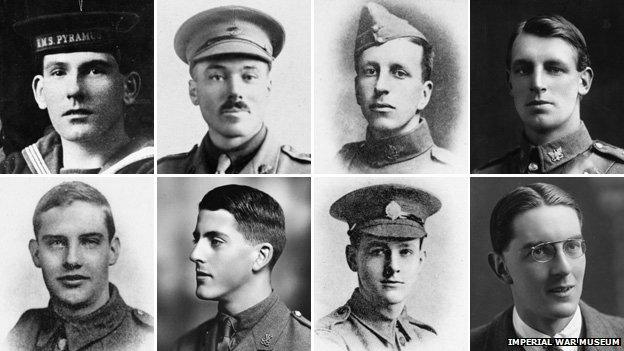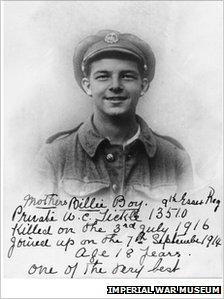Faces of World War I bring memories to life
- Published

The Imperial War Museum acquired the portraits between 1917 and 1920, following an international appeal advertised in war-time ration books as well as the press
This Armistice Day will be the first without World War One combat veterans. The Imperial War Museum is among those helping to keep their memories alive with the launch of a project based on the era.
Earlier this year, World War I passed from living memory into the pages of history.
British-born Claude Choules, known to his comrades as Chuckles, died in his sleep aged 110 in his adopted city of Perth, Australia.
He was the world's last-known combat veteran of the Great War.
In the UK, Remembrance Sunday has already changed. When the great and the good lay wreaths at the Cenotaph in London they no longer do so under the eyes of WWI veterans.
Bill Stone, Henry Allingham and Harry Patch - the last living veterans in the UK - all died in the same year, 2009.
This Armistice Day, the Imperial War Museum is hoping to keep alive their memories - and those of millions more who fought in WWI - by publishing 100 portraits of people who served in the war.
It will continue to publish additional portraits every weekday until August 2014, the 100th anniversary of the outbreak of the war.
Nigel Steel, historian at the Imperial War Museum says the project - called Faces of the First World War - will help reconnect people with the 1914-18 generation.
"The people who lived through those years are, by and large, all gone. We've moved out of the era of living memory. So we all have to work harder if we're to understand and remember events of that time," he said.

Pte Tickle was killed during the Battle of the Somme. The museum believes he was aged 17 when he died and that his mother wrote '18' in error.
The project would help people think about a period that stood at the "roots of modern Britain" and was part of a build-up to a much bigger commemoration in 2014, he said.
The portraits come from a collection of thousands of images acquired by the museum when it was founded in 1917. It appealed to people across the world to send the pictures, advertising in war-time ration books as well as newspapers.
Mr Steel says there is tendency to see World War I as something deep in history. But he thinks the faces of ordinary people featured in the project will engage people and catch their imagination.
"They're the same faces that you see on a Tube or on a bus. It's very easy to say 'that doesn't look so different from me'," he says.
Some of the photographs - such as that of Sgt J Oakley, Royal Horse Guards - have only a name, rank and unit. Other images are accompanied by detailed letters and biographies. In some cases, bereaved families donated their only photograph.
Handwritten note
One touching image is that of Pte William Cecil Tickle, complete with a handwritten note by his mother describing him as "one of the very best". Pte Tickle, of 9 Battalion, Essex Regiment, enlisted on 7 September 1914 and was accepted even though he was underage.
He was killed at the age of 17 on 3 July 1916, during the first Battle of the Somme - a battle in which Britain sustained tens of thousands of casualties. He is commemorated on the Thiepval Memorial in France which stands for soldiers with no known grave.
The portraits feature people from a range of military ranks and services from Britain and the Commonwealth.
Maj James Logie Harcus was an Orkney-born fluent Gaelic speaker who emigrated to Australia 1907, settling in Sydney. He served in the 20th Battalion, 5th Infantry Brigade, Australian Imperial Forces.
He volunteered on the outbreak of war and was part of the Australian force which took control of German colonies in Papua New Guinea in September 1914.
In 1915 he sailed with his battalion to the Middle East and participated in the landings at Suvla Bay, Gallipoli in August. He was killed in action, aged 34, at Tel el Kebir, on 11 December 1915.
Not all of those behind the portraits were killed during the war. L/Cpl Pat O'Keefe was a boxing champion who died in 1970 after many years as a publican.
Mr O'Keefe, born in London in 1883, began his boxing career in 1906. In May 1914 he won the English middleweight title.
During the war he served as a physical training instructor and continued to win several boxing bouts. He retired from the sport aged 35.
In a twist on its original appeal, the museum is hoping the public will be able to help staff find out more about the life stories of the those behind the pictures.
Organisers are uploading the images to the photo-sharing site Flickr, external and are inviting people to add comments, information or links to the photos.
"What modern technology allows us to do is to take an idea from 1917 and give it a new push into the 21st Century," says Mr Steel.
"The faces that the museum wanted to use to encapsulate the effort and the sacrifice of that generation can put it out there into the modern world.
"If we were fortunate, there might be someone out there who says - hang on a minute, that's my great uncle."
- Published5 May 2011